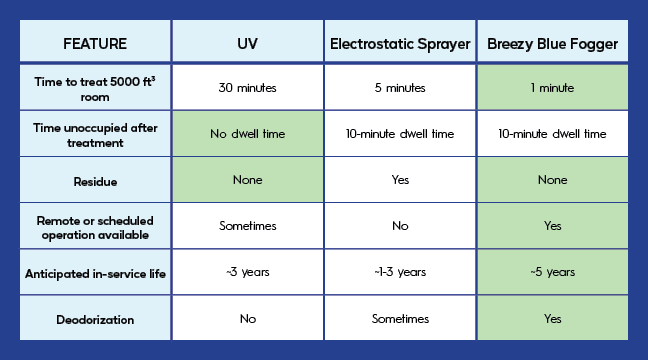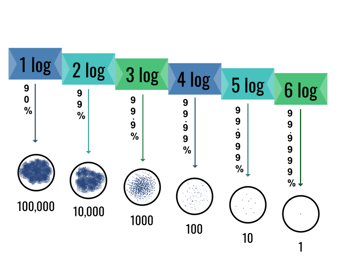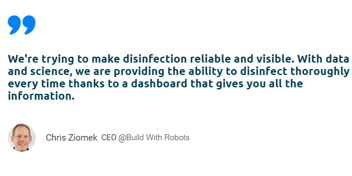
UV Disinfection vs. Electrostatic Sprayers vs. Disinfectant Fogging
Since 2020, new disinfection technologies have made their way into daily operations at many facilities. Some of the most popular innovations are UV disinfection, electrostatic sprayers, and disinfectant fogging. Each one works a little differently with unique advantages and disadvantages, and some are more suited for specific environments. Let’s dive into the differences and see which one would suit your workplace.
UV Disinfection
UV disinfection utilizes ultraviolet light to “kill” or inactivate microorganisms on surfaces. UV light damages the DNA and RNA of bacteria, viruses, and fungi, thereby rendering them inactive and stopping disease spread. UV disinfection devices come in many forms, from handheld devices to portable robots, and they emit UV-C radiation in a range of wavelengths.
One benefit of UV disinfection that distinguishes it from the other two methods is the fact that there is no disinfectant chemical needed. Disinfectant is a recurring cost for electrostatic sprayers and foggers, so UV is a simpler, low-maintenance option. Plus, because there is no chemical involved, people can re-enter a space immediately after disinfection.
However, UV disinfection has some drawbacks. It can only disinfect surfaces that are directly exposed to the light, so any shadow areas in a space will not be disinfected. Hard-to-reach areas such as backs of chairs, underneath desks, and more are missed, as well as any items that are blocked by large pieces of furniture. Additionally, prolonged exposure to UVC radiation is harmful to humans, so proper safety precautions are necessary when using this technique.
Electrostatic Sprayers
Electrostatic sprayers use a specialized nozzle to create an electrostatic charge on disinfectant particles, which then adhere to surfaces and spread around evenly for full coverage. This technique can disinfect large areas quickly and efficiently, and it is particularly useful for disinfecting complex or irregularly shaped objects.
This method is faster than UV disinfection - it can disinfect a 5000 ft3 room in about 5 minutes, whereas UV would take 30 minutes. It also reaches spots that UV would miss since a person is in control of the electrostatic sprayer and can move around the room.
However, this technique requires PPE and uses backpack sprayers, in which disinfectant is held on a person’s back and they walk around spraying areas to disinfect. The weight of the backpack takes a toll on workers, and it takes time to complete the task, especially in a large facility. Additionally, the droplets produced by electrostatic sprayers do not penetrate deeply into porous surfaces, so furniture and upholstery will not be completely free of germs. These droplets also leave residue on surfaces and need 10 minutes of dwell time before people can re-enter the space.
Disinfectant Fogging
Disinfectant fogging is a technique that involves dispersing a fine mist of disinfectant throughout a room or area. The mist settles on all surfaces, including hidden and hard-to-reach areas, providing complete coverage. Like UV devices, disinfectant fogging can be done with autonomous robots like Breezy One, or smaller, portable units such as Breezy Blue. Fog droplet size varies based on the product, but Breezy foggers disperse disinfectant at 20-100 microns, or the size of a speck of dust.
Fogging is a quick option - a 5000 ft3 room needs only 50 seconds of fogging for full coverage, including all the spots that UV misses and the spots that a person would miss when using electrostatic sprayers. The fog droplets are small, so no residue is left behind, and the droplets hang in the air to disinfect and deodorize the space. In the case of Breezy Blue, the anticipated in-service life is about 5 years, whereas UV devices and electrostatic sprayers last around 1 to 3 years before needing maintenance or replacing. Plus, Breezy Blue is an automated fogger, so it can be operated with a remote or set to fog on a schedule. This hands-off method gives workers time for other tasks.
However, disinfectant fogging is not perfect. Like electrostatic spraying, it requires a chemical solution and needs to be refilled on occasion, and this is a recurring cost. Also, the disinfectant has a dwell time of 10 minutes to ensure thorough disinfection, so people cannot re-enter the room immediately after fogging.
Which Method is Right for You?
Every facility has different needs, and any method can work for you. For simple layouts with flat surfaces that need disinfection, UV may be the best option. For well-staffed facilities with large spaces, electrostatic sprayers could be a great fit. For understaffed workplaces that need thorough disinfection with minimal labor, disinfectant fogging may be the best choice. In some cases, it is beneficial to use multiple methods for different areas of a facility because many factors can vary from room to room.
For a quick overview of the mentioned features and more, check out this comparison of disinfection methods.




